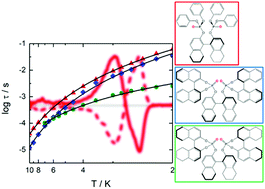Luminescent dysprosium single-molecule magnets made from designed chiral BINOL-derived bisphosphate ligands†
Abstract
A series of three mono-dimensional polymers [Dy(hfac)3((S/R)-L2)]n ((S/R)-2), [Dy(hfac)3((S/R)-L3)]n ((S/R)-3) and [Dy(hfac)3((S/R)-L4)]n ((S/R)-4) involving different binaphthyl-2,2′-diyl phosphate ligands ((S/R)-L2–4) were designed from our pioneer reported system of formula [Dy(hfac)3((S/R)-L1)]n ((S/R)-1). The single-crystal X-ray diffraction structures revealed that the final compounds are in their enantiopure form with the ligands bearing the same chirality in the free and coordinated mode. All the polymers can be described as assemblies of mononuclear single-molecule magnets (SMM) in both zero and applied magnetic field. The fitting of the thermal dependence of the relaxation times shows that magnetic relaxation takes place through a combination of thermally activated mechanism (Raman) and quantum tunneling of the magnetization (QTM in zero applied magnetic field). The effect of the nature of the antenna and the number of chiral centres of the BINOL-derived bisphosphate ligands on both chiroptical and magnetic properties were studied. Photophysical and magnetic properties were rationalized by TD-DFT and ab initio calculations. Finally magneto-structural correlations between Dy(III) luminescence, calculations and magnetism were performed.



 Please wait while we load your content...
Please wait while we load your content...